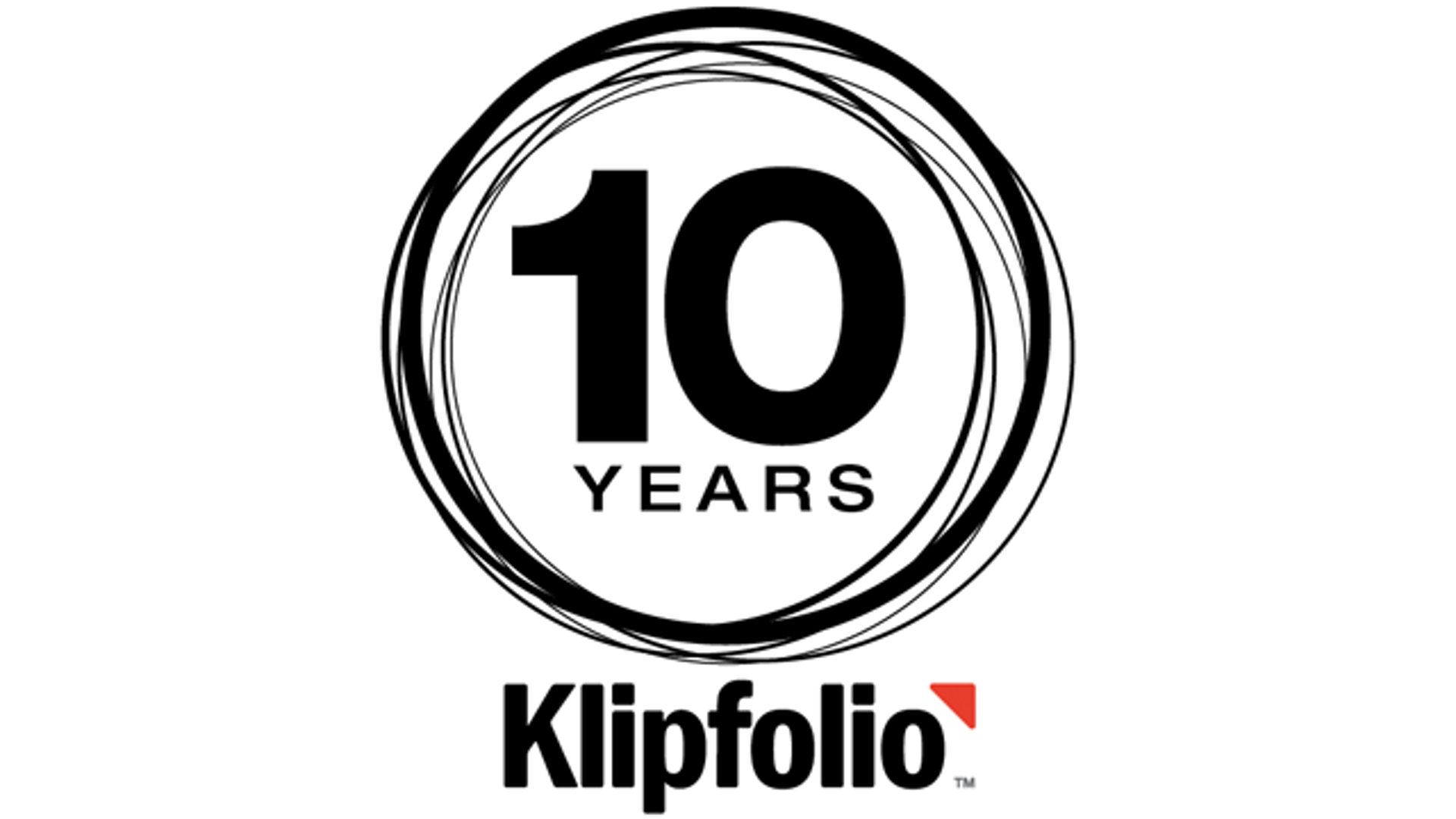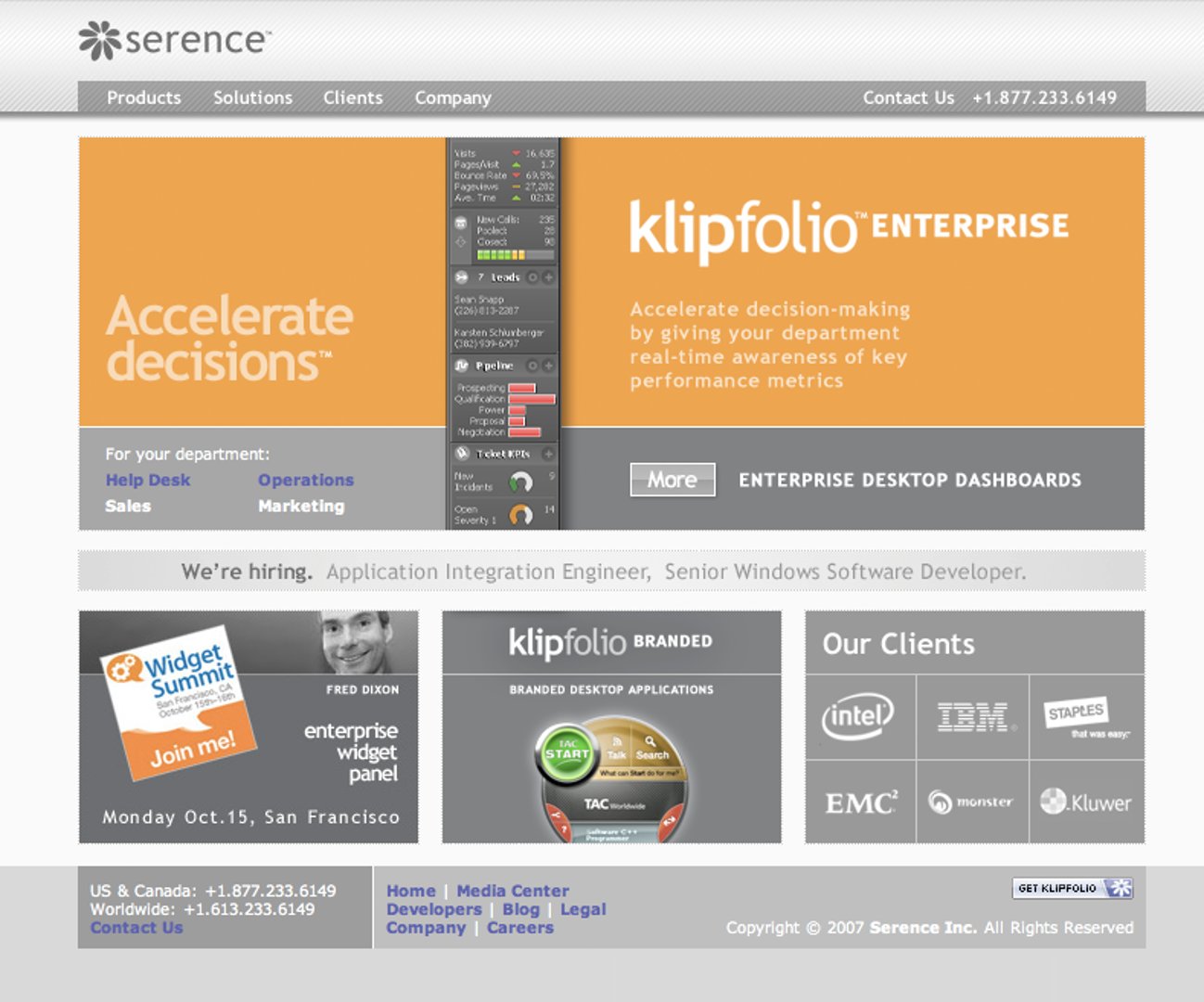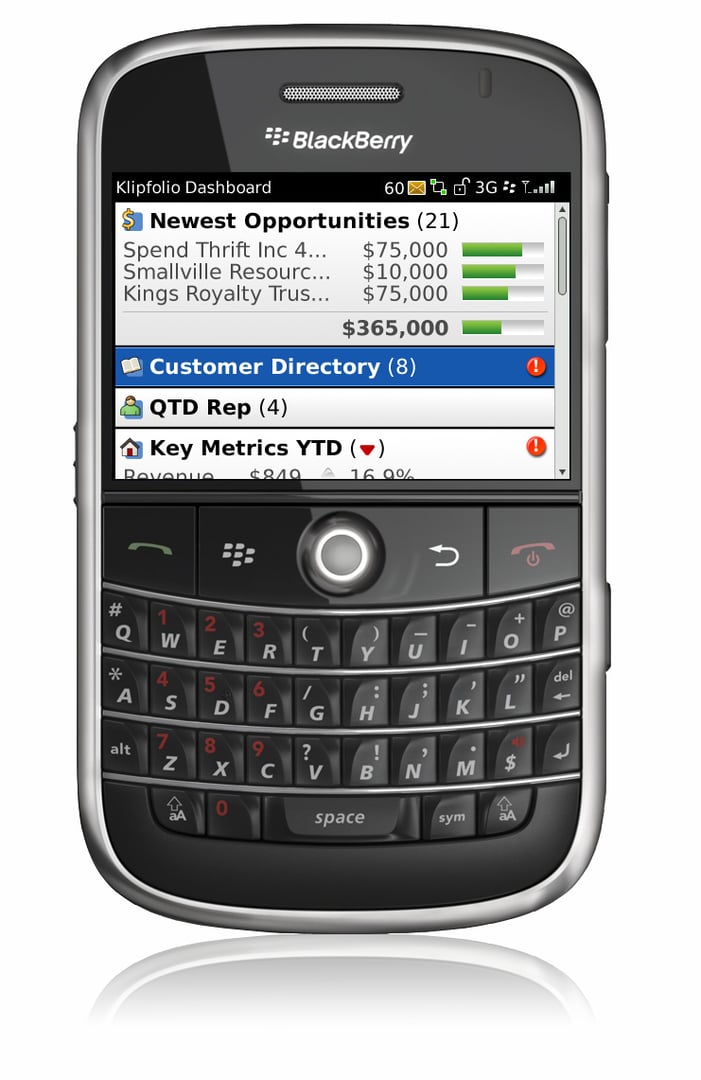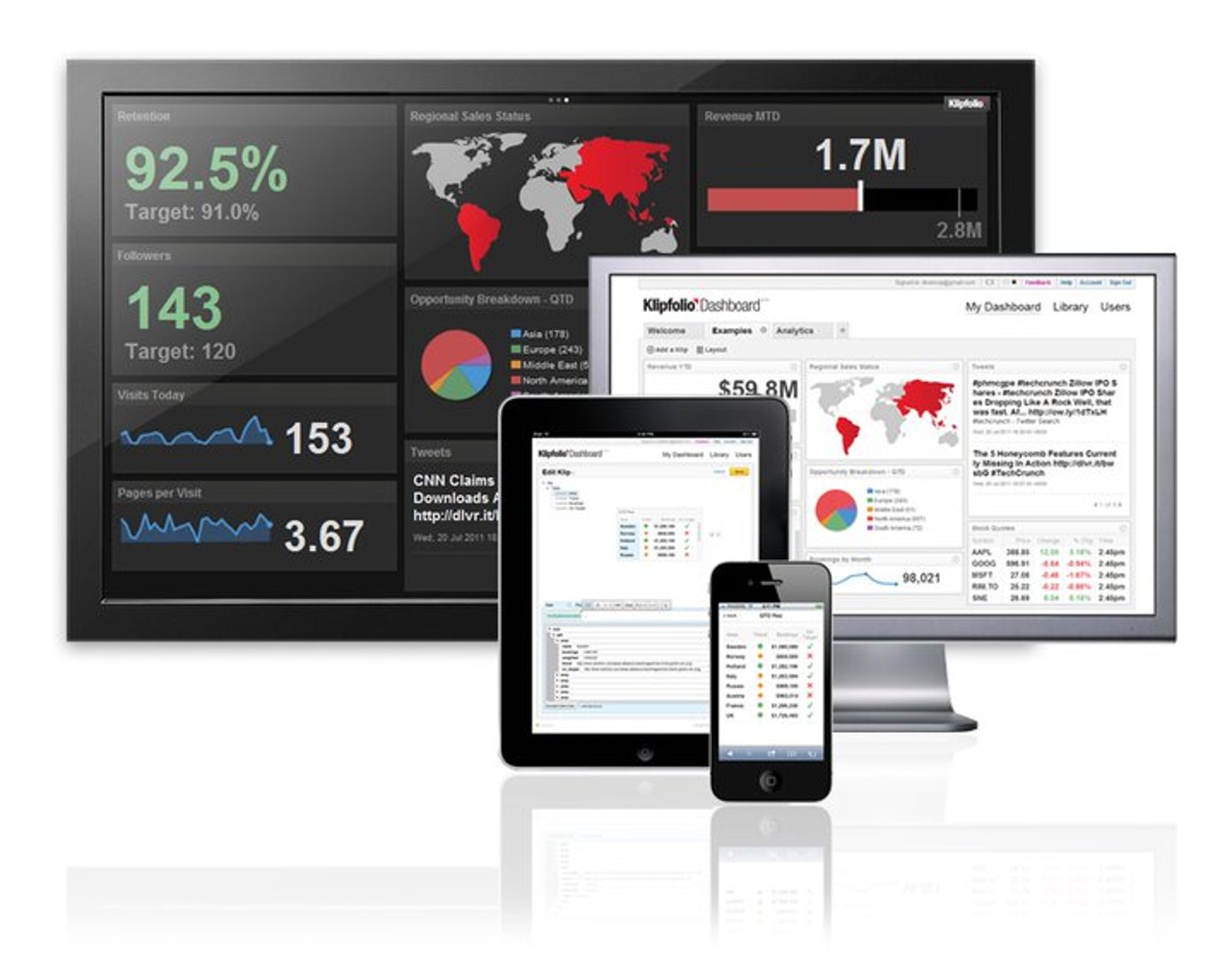Part 3: The history of Klipfolio

Published 2023-11-27
Summary - In the final instalment of the history of Klipfolio, the team navigates the turbulence of a global recession and emerge as a leading desktop KPI and mobile BI dashboard vendor.
When, in 2007, the team was considering a transition into operational business intelligence (BI), their decision crystallized with the aid of an early win: Lufthansa, Europe's largest airline, adopted Klipfolio's KPI dashboard organization wide. That big win, however, was followed in late 2007 with the increasing certainty of a new global recession. Big and small companies alike were tightening their belts and looking to do more with less. The economic outlook had the team nervous heading into 2008.
Before we look at how the team dealt with the recession, let's take a step back and understand what business intelligence is and why the team decided to move into that market.
Operational business intelligence is often summed up as providing the right information to the right people at the right time. This simple definition alludes to the three major components of a business intelligence strategy. First, you need to gather information about your organization's performance and frame that information in a way that is actionable. More often than not, the result of this step is to formulate KPIs (key performance indicators) to guide strategic and tactical decisions. Second, you need to determine who will benefit the most from having that knowledge. Third, you need to provide those people with access to that knowledge in a clear and trusted manner so that actions can follow. As you may have guessed, the third component - a KPI dashboard that is easy to use and pervasively accessible - is what Allan, Peter, and James were most excited about.
The team recognized the opportunity as early as 2001, and as they gained experience and expertise over the years, they became more confident that Klipfolio Dashboard could handle the real time data, scalability, and features demanded of enterprise-class customers. From the outset, the Klipfolio platform was about managing frequently changing data that came from multiple, disparate sources. At the center of this platform is the Klip, a unique reporting device that consolidates and presents data and can be organized with other Klips on a dashboard. The question facing the team in early 2007 was whether Klips could be used by developers to display a KPI just as easily as it could a news feed. As it turns out, Klipfolio Dashboard was more than up to the challenge.

With Lufthansa as their first KPI dashboard customer - and a big one at that - the team decided to enter the operational BI market, and exit the branded desktop application space, despite that market being at its peak in 2007. However, in late 2007, as the uncertainty of the global economy wrecked havoc on small and large businesses alike, the team prepared for lean times. On one hand, they knew that KPI dashboards had a potentially huge ROI (Return on Investment) and could have a measurable impact on the operational performance of any organization. On the other hand, the ROI of dashboards is largely intangible and for businesses shoring up expenses, the question of whether to invest capital into a KPI dashboard could be a deal breaker.
As it turned out, business intelligence vendors fared well throughout the recession. The lean years convinced organizations that they needed to do more with less and they turned to BI and dashboards as a solution to this problem. The team followed up their success with Lufthansa in 2007 with more big wins, adding EMC, Baxter Healthcare, and IBM to their list of globally recognized customers. "When the recession hit, we were more than a little nervous," recalls Allan Wille. "Our concerns proved to be unfounded as enterprises started turning to KPI dashboards as a way to stay competitive even as they tightened their belts."
A fact that has been glossed over a bit in this history is that from 2001 to 2008 the company went by the name of Serence. The name "Klipfolio" was initially reserved for the dashboard products, but with the success and visibility of the KPI dashboard, the distinction between the two names proved to be a distraction. Following much internal debate, and a legal name change, the full rebranding of the company from Serence to Klipfolio took off in December 2008. The decision to change the company's name was symbolic of the team's maturation and officially signaled Klipfolio's exclusive focus on the enterprise BI space. The rebranding was a huge success, and the team tracked an immediate increase in leads, inquiries, and customer wins.
While Klipfolio continued to enjoy success in the desktop KPI dashboard market, behind the scenes the team was itching to tackle a new opportunity. One of the core principles of the company is that data should be easily accessible to everyone. This had led to experiments with mobile consumer dashboards in 2004, and those ideas resurfaced in 2009. While the earlier foray into the mobile market had been focused on consumers, the team's attention was now firmly set on mobile BI. In 2009, the research and development team began developing a mobile BI dashboard using the BlackBerry OS. Although the team ultimately decided against building a client for an operating system, they were convinced that mobile dashboards were the future of business intelligence.

Business intelligence analysts unanimously agree that mobile BI is the next big thing, and the team whole-heartedly agreed with this sentiment. "Unlike analytical BI, operational or real-time business data is broadly applicable," says Allan Wille. "For us, mobile BI is an opportunity to truly achieve our goal of pervasive access to data, organization wide." In the rush to deliver mobile BI solutions many vendors fell into the trap of simply porting their existing products to mobile devices. The result was a cramped mobile dashboard with confusing and inappropriate functionality. This was something that the team wanted to avoid, even if it meant delaying entry into mobile BI.
In 2010, their mobile BI went from research into full-fledged development, rallying around HTML5 and a cloud-based infrastructure. This way, the mobile dashboard would be platform and device independent and accessible via any smartphone, tablet, or Internet browser. Klipfolio's mobile BI wouldn't just be accessible - it would also be fully functional and even capable of being a stand-alone business intelligence solution for small-to-medium sized organizations.
On June 22, 2011, Klipfolio announced the Beta for their new cloud dashboard. The development of Klipfolio Dashboard web and mobile involved some of the world's largest brands and most security conscious organizations. Throughout the Alpha and Beta testing in 2010/2011, Klipfolio worked closely with these customers to ensure that the mobile dashboard would not only live up to expectations, but exceed them.
On September 27, 2011, almost exactly 10 years after the company was founded by Allan Wille, Peter Matthews, and James Scott, Klipfolio Dashboard web and mobile was released. This news was quickly followed up by a string of new customers, including Aviva, Blue Cross Blue Shield, and Emrill. Klipfolio gained important new global partners increasing the visibility of both the desktop and mobile BI products. The launch of Klipfolio Dashboard for web and mobile was a huge success and capped off 10 years of hard-work.

And, as if to signal Klipfolio's emergence as a leading dashboard vendor, 2011 closed as being the most successful year in the company's history. Not only did the team boast new world-class clients, new strategic partners, and the successful release of a new product, but the company recorded a doubling of YoY sales in 2011. Even more remarkable was the fact that it was the second straight year that the team had doubled Klipfolio Dashboard revenues.
In 2001, when Allan, Peter, and James founded the company, they did so with the goal of making data visible and accessible. That objective is not just a mission statement, but the guiding principle shared by everyone at Klipfolio. The product has matured and evolved from a consumer dashboard to branded applications and at last as a KPI dashboard. While the way the product has been applied has changed over the years, the team remains dedicated to bringing data visibility to the next level.
Even as we wrap up this history, a new chapter is being written for the story of Klipfolio. Surely, that chapter will include the evolution of Klipfolio's line of products, but more importantly it will be about the maturation of the company as a whole. Guided by Allan Wille, Peter Matthews, and James Scott, and backed by an innovative and energetic team, it already appears that that next chapter will be as interesting and intriguing as the ones that preceded it.





